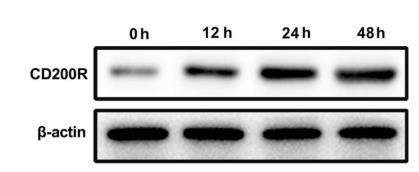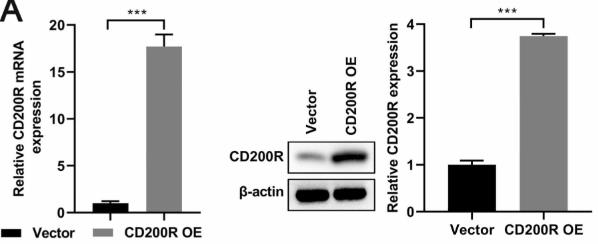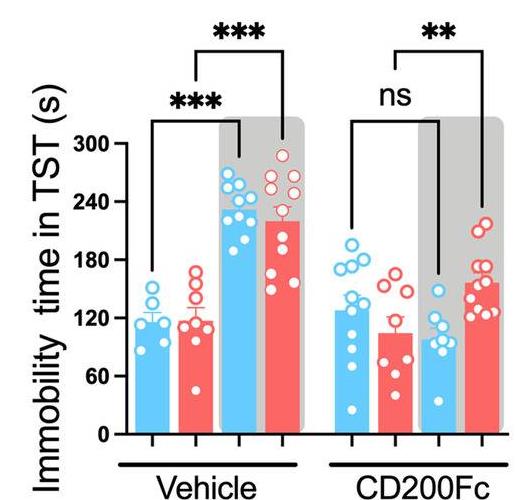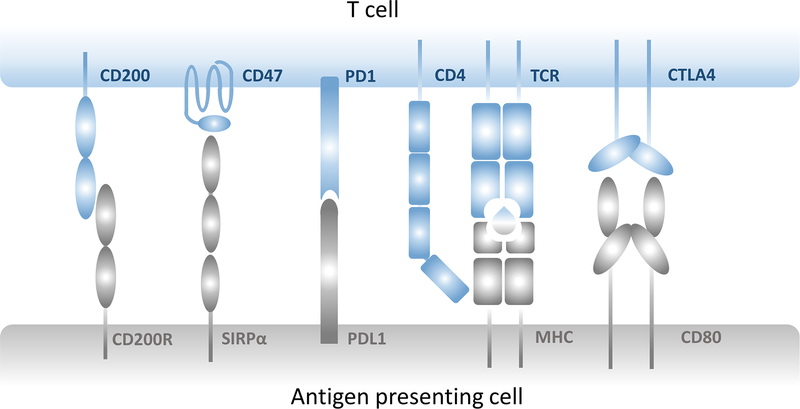Recombinant Human CD200R1 protein(Met1-Leu266), His-tagged
| Cat.No. : | CD200R1-3202H |
| Product Overview : | Recombinant Human CD200R1 (AAI43394.1) (Met 1-Leu 266) was expressed in HEK293, fused with a polyhistidine tag at the C-terminus. |
- Specification
- Gene Information
- Related Products
- Case Study
- Application
- Download
| Species : | Human |
| Source : | HEK293 |
| Tag : | His |
| Protein Length : | 1-266 a.a. |
| Form : | Lyophilized from sterile PBS, pH 7.4. Normally 5 % - 8 % trehalose, mannitol and 0.01% Tween80 are added as protectants before lyophilization. |
| Bio-activity : | Measured by its binding ability in a functional ELISA. Immobilized human CD200R1 at 1 μg/ml (100 μl/well) can bind human CD200 with a linear range of 0.12-16 ng/ml. |
| Molecular Mass : | The secreted recombinant human CD200R1 comprises 251 amino acids after removal of the signal peptide and has a predicted molecular mass of 28.2 kDa. As a result of glycosylation, rh CD200R1 migrates as an approximately 50-60 kDa band in SDS-PAGE under reducing conditions. |
| Endotoxin : | < 1.0 EU per μg of the protein as determined by the LAL method |
| Purity : | > 98 % as determined by SDS-PAGE |
| Storage : | Samples are stable for up to twelve months from date of receipt at -20°C to -80°C. Store it under sterile conditions at -20°C to -80°C. It is recommended that the protein be aliquoted for optimal storage. Avoid repeated freeze-thaw cycles. |
| Reconstitution : | It is recommended that sterile water be added to the vial to prepare a stock solution of 0.2 ug/ul. Centrifuge the vial at 4°C before opening to recover the entire contents. |
| Gene Name | CD200R1 CD200 receptor 1 [ Homo sapiens ] |
| Official Symbol | CD200R1 |
| Synonyms | CD200R1; CD200 receptor 1; MOX2 receptor , MOX2R; cell surface glycoprotein CD200 receptor 1; CD200R; HCRTR2; OX2R; MOX2 receptor; CD200 cell surface glycoprotein receptor; cell surface glycoprotein OX2 receptor 1; cell surface glycoprotein receptor CD200; MOX2R; |
| Gene ID | 131450 |
| mRNA Refseq | NM_138806 |
| Protein Refseq | NP_620161 |
| MIM | 607546 |
| UniProt ID | Q8TD46 |
| ◆ Recombinant Proteins | ||
| Cd200r1-2054M | Recombinant Mouse Cd200r1 Protein, Myc/DDK-tagged | +Inquiry |
| Cd200r1-458M | Active Recombinant Mouse Cd200r1, Fc Chimera | +Inquiry |
| CD200R1-3523C | Recombinant Chicken CD200R1 | +Inquiry |
| CD200R1-3483C | Active Recombinant Cynomolgus CD200R1 Protein, His-tagged | +Inquiry |
| CD200R1-0988H | Recombinant Human CD200R1 Protein (Met1-Leu266), C-His tagged | +Inquiry |
| ◆ Cell & Tissue Lysates | ||
| CD200R1-2523HCL | Recombinant Human CD200R1 cell lysate | +Inquiry |
| CD200R1-2483CCL | Recombinant Cynomolgus CD200R1 cell lysate | +Inquiry |
| CD200R1-2226MCL | Recombinant Mouse CD200R1 cell lysate | +Inquiry |
Case 1: Hu Y, et al. Tissue Cell. 2024
Diabetic retinopathy is a leading cause of vision issues globally, largely due to oxidative stress, but the role of CD200R protein in this process isn't clear. In this research on human retinal cells, they observed that high glucose levels boosted CD200R expression over time. Reducing CD200R helped decrease oxidative stress and improved cell health, particularly when using ROS scavengers. Researchers also discovered that the AKT/mTOR pathway is involved, as knocking down CD200R affected protein expressions related to this pathway. Blocking mTOR with Rapamycin significantly reduced stress caused by high glucose, highlighting a potential treatment target for diabetic retinopathy.

Fig1. WB of CD200R protein expression.

Fig2. ARPE-19 cells were transfected with an empty vector (EV) or plasmid expressing CD200R.
Case 2: Chen X, et al. J Neuroinflammation. 2023
Neuroinflammation and microglia contribute significantly to depression, with CD200, a protein found in neurons, and its receptor CD200R1, located in microglia, being key players. However, their exact role in depression isn't fully known. In studies using chronic social defeat stress (CSDS) in mice, researchers found that CD200 levels dropped in a brain area related to stress. Boosting CD200 helped reduce signs of depression, while its reduction made mice more stress-sensitive. Moreover, when CD200R1 receptors on microglia were reduced, CD200 couldn't ease depressive symptoms. Microglia were more active after stress exposure, but increasing CD200 calmed them, reduced inflammation, and boosted brain cell growth, helping counteract stress-induced neurogenesis issues.

Fig1. Representative immunostaining for CD200R1 (green)/Iba1 (red)/DAPI (blue) in the DG.

Fig2. Analysis of immobility time in TST of control and CSDS mice injected with LV-siCD200R1 and CD200Fc.

Fig1. CD200:CD200R1 axis. (Katarzyna Kotwica-Mojzych, 2021)

Fig2. CD200-CD200R axis is considered to be a pair of checkpoint molecules that regulate tumor-specific immune responses. (Jin-Qing Liu, 2020)
Not For Human Consumption!
Inquiry
- Reviews
- Q&As
Ask a Question for All CD200R1 Products
Required fields are marked with *
My Review for All CD200R1 Products
Required fields are marked with *
Inquiry Basket


